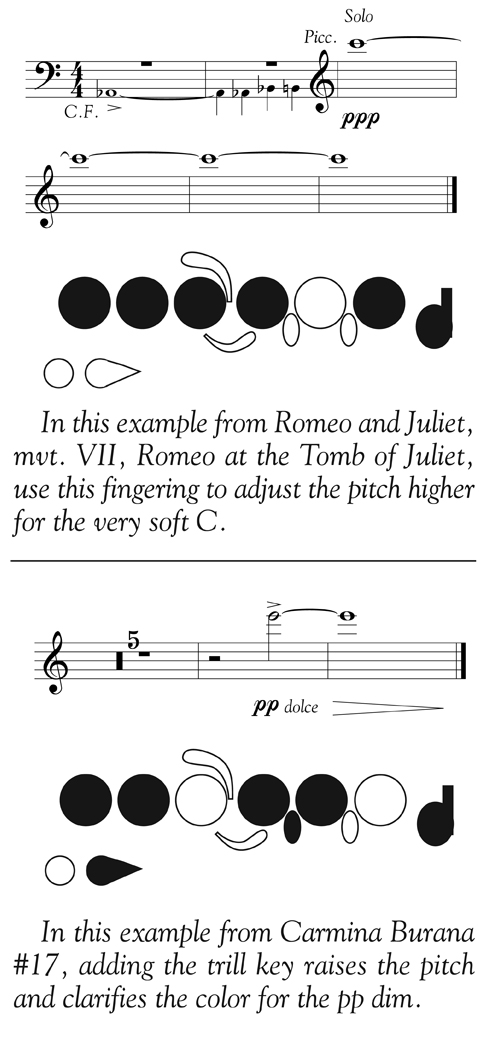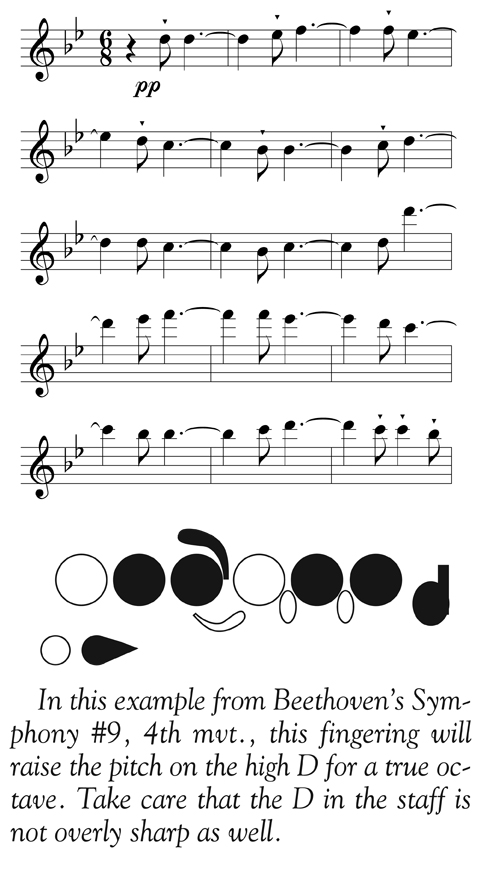My orchestra conductor Carl St. Clair said in a rehearsal, “Think about the most important things that have ever been said to you, they have been said softly.” This quote has really stuck with me because there is a so much truth to the statement. Playing softly on the piccolo can be a challenge for some players, but it is worth the work to produce a beautiful soft, shimmering sound.
Embouchure
First of all, make sure that the piccolo headjoint is aligned slightly to the outside of the center of the midline as this will keep you from covering too much of the embouchure hole. Place the piccolo slightly higher on the lower lip than you would place a flute. This will raise the angle of the air slightly and free up the tone.
Since a piccolo is about half the size of a flute, piccolo players should be certain that they are allowing the air to reach the back wall of the embouchure hole at an optimum angle. They also should not cover too much of the embouchure hole.
Basic embouchure control comes from the center of the lips, not the corners. Say the word pure. Feel how the lips come forward on the vowel sound, and notice how the corners are controlled, but never stretched back tightly (as in a smile). Notice also that there is a little space between the top lip and front teeth. It helps to imagine blowing a kiss to somebody across the room. Again notice that there is more of a sense of forward motion to the lips, rather than a squeezing motion. This is the opposite of the feeling of keeping the lips pursed together.
When playing softly, never pull the top lip down towards the bottom lip. As in playing flute, moving the lower jaw, lips, and tongue forward helps send the sound away from you at softer dynamic levels. Keep the aperture smaller as well, but make sure you are not squeezing. A good image for keeping a small aperture might be like slurping in that last strand of spaghetti. Playing soft requires a tiny aperture.
Air Column
Playing softly takes more energy than playing loudly, but it is a different kind of energy. Keep the throat open and free. I always notice that the air is spinning in my mouth much more at a piano dynamic, and I am aware of the subtle back pressure from support (that feeling of pushing down or out while exhaling). Tone production on the piccolo is based on using stronger support but less quantity of air than flutists use. The tone will be harsh and brassy if a player uses air volume or a large quantity of air to produce the tone. Use a firm, concentrated air stream and think about speed and support (compression) rather than using a large quantity of air. Lifting the rib cage and sternum to control the air helps keep the pitch from dropping at the ends of phrases or during long sustained notes. I have always incorporated piano long tones into daily piccolo practice routine so that I get used to the balance of air pressure on the long, sustained exhalation.
Fingerings
It really helps to have a good command of alternate fingerings to use when playing softly. The basic intonation of the piccolo is very different than the flute. For example, C#5 is usually quite sharp on the flute but is a notoriously flat note for most piccolos. Of course there also are huge variances in pitch from instrument to instrument with the piccolo, much more so than from flute to flute. Know your instrument’s basic tendencies and study fingering guides for ideas that can raise pitch or lower pitch on the same note as you might want to adjust in either directions depending on the circumstances. There are several high-register notes that are often flat no matter what the dynamic level, so make adjustments to blow slightly higher or roll slightly with the right hand to keep the pitch high enough. Work carefully with a tuner to learn the tendencies of the alternate fingerings, which will become more primary in many circumstances. Never try to hide on the piccolo as this causes a host of issues from sagging support to a slower air speed. Play with confidence and remember that high frequencies are sometimes perceived as louder just because they are higher. Sometimes it helps to play more into the music stand, which acts as a sound baffle for particular passages. Trumpet players in particular seem to use this technique to help dampen the sound and limit projection.


Learning to play softly on the piccolo is rewarding and will give you some incredibly satisfying musical moments. It is a question of getting the correct embouchure position, correct alignment (of the instrument and the player’s body), air support and fingerings working together to create the desired dynamic. You will be able to say the most important musical things…softly.






